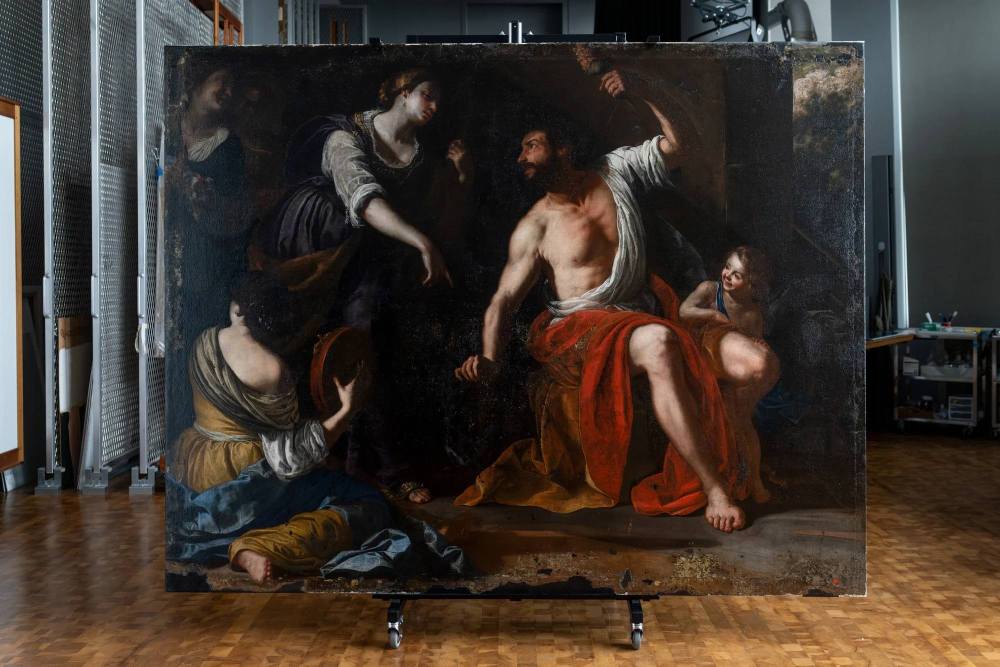
Meaning of Artemisia Gentileschi’s Hercules and Omphale Painting
Artemisia Gentileschi’s Hercules and Omphale is a newly rediscovered and magnificently restored baroque masterpiece, widely regarded as a pivotal work in her later Neapolitan period (c. 1635–37). The painting, an imposing 2 × 2.5 m oil on canvas, debuted publicly for the first time in Los Angeles in mid‑2025, anchoring the Getty Museum’s exhibition “Artemisia’s Strong Women: Rescuing a Masterpiece”, and will later travel to the Columbus Museum of Art before returning home to Beirut.
What Is Hercules and Omphale About?
Rooted in the classical myth, the painting portrays Hercules punished for the murder of Iphitus, his expiation being enforced servitude to Queen Omphale of Lydia. In a dramatic gender role reversal, the mighty demi‑god is shown spinning wool, an emblem of feminine labor, while Omphale, draped in his lion skin and wielding his club, gazes affectionately at him. Cupid watches over the pair, marking the transformation from punishment to romance.
🧑🎨 Who Painted It, and How?
Artemisia Gentileschi (1593–1654/52) stands among the leading Baroque painters of her time, celebrated for breathtaking chiaroscuro and female empowerment themes. Documented across Rome, Florence, Venice, Naples, and London, her career is marked by fearless historical scenes and personal triumph over adversity.
This piece is possibly her second version of the subject; the first, commissioned in 1628 for Spain, was likely lost in the 18th century. The Naples painting was recorded in a Neapolitan collection in 1699 with nearly identical dimensions, a strong match to the Sursock painting.
Thanks to Lebanese art historian Gregory Buchakjian, who first noted the work in Sursock Palace in 1993, this painting’s attribution was quietly suspected until the 2020 Beirut blast drew attention to it. The unveiling of his research in Apollo Magazine catalyzed its proper scholarly recognition.
⚙️ Restoration After Beirut’s Devastation
The August 4, 2020 Beirut port explosion inflicted severe damage, windows shattered, debris pierced the canvas, embedding glass shards and plaster. The Sursock Palace, which had displayed the painting for over a century, was battered.
Flight to safety came when the Getty’s conservation team, led by Ulrich Birkmaier with assistance from the Italian restorer Matteo Rossi Doria, undertook a painstaking three‑year recovery. The process involved:
Removing embedded glass and debris, documented via x‑rays and photos
Relining the canvas on a flexible stretcher
Inserting matching canvas to repair tears and filling holes with textured grafts
Cleaning centuries of varnish to reveal Artemisia’s vibrant pigments
Confirming her authorship through stylistic markers like Omphale’s detailed jewelry
Symbolism & Interpretation
Gender & Power Reversal:
The image of male heroism subverted, Hercules performing women’s tasks, challenges 17th‑century gender expectations. The lion skin and spindle symbolize roles transposed and new authority dynamics.The Transition to Affection:
Cupid’s presence and the affectionate eye contact signal a shift from enforced servitude to genuine intimacy, echoing themes of control, vulnerability, and emotional transformation.Artistic Ambition & Workshop Identity:
Representing a large-scale, multi-figure history painting was rare for female artists then, Artemisia boldly engaged with complex literary subjects. This work exemplifies her strategic branding and entrepreneurial spirit in Naples.
Current & Future Home
Now on Display: J. Paul Getty Museum, Los Angeles (June 10 – September 14, 2025)
Upcoming: Columbus Museum of Art, Ohio (Oct 31, 2025 – May 30, 2026)
Permanent Return: Long-term loan at Getty, with eventual return to Beirut’s restored Sursock Palace under UNESCO’s LiBeirut heritage initiative.
What Type of Art?
A commanding example of Italian Baroque, Hercules and Omphale exhibits powerful tenebrism, dynamic composition, rich color palette, and psychological nuance. While Artemisia is famed for female protagonists, such as Judith or Lucretia, this monumental male figure is exceptionally rare in her oeuvre.
Why It Matters
Art Historical Significance: Enriches Artemisia’s catalog and highlights her late-career sophistication and influence in Naples.
Cultural Salvage: A testament to Beirut’s resilience and emerging heritage reconstruction, its survival reflects global dedication to art conservation.
Gender & Myth in Dialogue: Serves as a compelling visual discourse on role reversal, love, and the power of myth, rendered by one of history’s most progressive painters.
Hercules and Omphale stands as a cultural phoenix, reborn from tragedy and restored to full artistic potency. Artemisia’s commanding brush renders a nuanced tale of power, subversion, and love. As the painting tours global institutions and returns to its Beirut roots, it reminds us of the enduring importance of safeguarding art. Above all, it reinforces Artemisia’s legacy, not just as a survivor of personal trauma, but as a fearless, inventive Baroque master whose vision resonates across centuries.
By unpacking the painting’s mythology, technique, symbolism, and incredible restoration story, we not only celebrate Artemisia’s achievement but also reaffirm the transformational power of art to transcend time and tragedy. image/Cassia Davis/J. Paul Getty Trust



